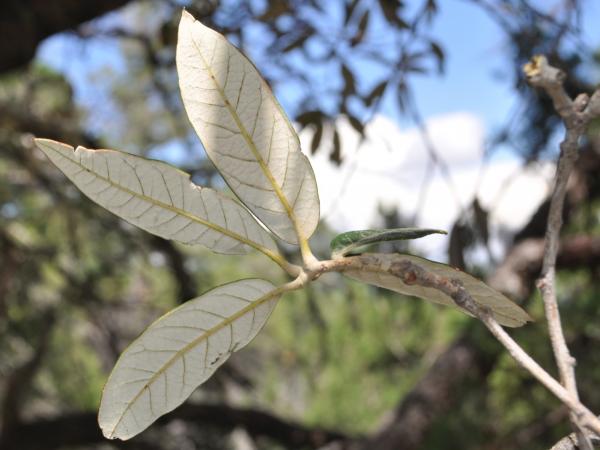Editor's Picks
Plant Focus
Californian Oaks in Canberra
 |
| A judiciously pruned mature Quercus engelmannii on Caldenia St., O'Connor, Canberra {click on images to enlarge) |
Last April I briefly visited Canberra, the capital of Australia. I was able to take a day off to look at trees and spent most of it admiring the impressive collections of Australian native flora at the Australian National Botanic Gardens. This was my first trip to Australia and I had been looking forward to the diversity of its endemic trees. But Canberra also offered a quite unexpected treat: several Californian oaks used in well-maintained plantings along residential streets.
Canberra was built as a planned city. When Australia needed to choose its capital at the beginning of last century, rivalry between its two largest cities, Sydney and Melbourne, led to the decision of creating a custom-built city in a location roughly equidistant from the two metropolises. Constructing a city from scratch provides the opportunity for creative urban design and architecture. Another example of a capital created ex nihilo, Brasilia in the interior of Brazil, provided a tabula rasa for the architectural masterpieces of Oscar Niemeyer. Canberra may not be famous for its architecture, but it did offer an opportunity for horticultural experimentation, and in particular for the selection of urban trees. The diversity of its street trees is due to the work of pioneering horticulturists, notably Charles Weston and later Lindsay Pryor, who experimented with native and exotic trees to select those best suited to Canberra’s demanding conditions (cold winters with frequent frosts, hot dry summers) and to the requirements of city dwellers.
 |
| Quercus lobata acorns ripening on Clianthus St., O'Connor, Canberra |
While Australia offered a large variety of native species, these were not well-suited for the purpose of urban plantings. As Lindsay Pryor explains in the introduction to his book Trees and Shrubs in Canberra:
The trees which are considered best in towns and cities throughout the world are seldom undeveloped wild species. A successful city tree must have special characteristics, and usually these emerge only if there has been improvement by selection and breeding, intentional or otherwise.
The Australian native vegetation is still at a disadvantage compared with introduced plants because of this lack of adaptation. Another reason why native vegetation cannot meet all requirements is that in a place as cold as Canberra in winter the needs of an Australian urban community demand that deciduous trees play a prominent part in the landscape. Deciduous trees, which allow sunlight in winter and provide shade in summer, are ideal for many purposes near buildings and houses. Therefore, the idea sometimes expressed of using only one group of plants, either native or exotic, is not a practical one. Both groups have their place in the Canberra landscape.
 |
| Quercus douglasii |
Quercus was one of the genera chosen for experimentation, and several of the more common species can be found in Canberra: Quercus robur, Q. ilex, and Q. cerris from Europe, Q. rubra and Q. palustris from North America. Species from drier Mediterranean regions, such as Q. suber, Q. faginea, and Q. canariensis, were also introduced. Oaks from eastern U.S. that can be found in the city’s streets and parks include Q. macrocarpa, Q. bicolor, and an occasional Q. phellos. California was evidently selected as a region with a climate close to that of Canberra’s, for there are a remarkably high number of Californian oaks species in Canberra. In the residential district of O’Connor, there are three conjoining streets each planted with Q. lobata, Q. douglasii, and the relatively rare Q. engelmannii. I was particularly impressed by the wide variety of forms: within the same species one finds specimens with contrasting leaf size and shape, and different acorn size. This suggests efforts were made to obtain seed from different populations. Other Californian species are reported by Pryor to have done well in Canberra, including Q. kelloggii, Q. agrifolia, and Q. wislizeni, but I was not able to find them on this visit. I had not imagined that a trip to Canberra would serve as a warm-up for the upcoming Conference and associated Tours in California!
| Lobelia St., planted with Quercus douglasii |
| An allée of Quercus engelmannii on Caldenia St. |
| Different leaf forms on blue oak (Quercus douglasii): rounded lobes (above) and slightly pointed lobes (below) |
| Clianthus St. is lined with valley oaks (Quercus lobata) |
| Jumbo-sized Quercus lobata acorns on a tree on Clianthus St. |
| Engelmann's oak (Quercus engelmannii) with slightly lobed leaves (above) and unlobed leaves (below) |
All photos © Roderick Cameron



















